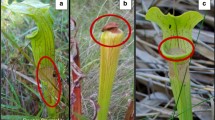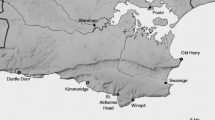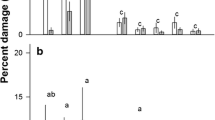Summary
The acceptance of secondary plant metabolites as herbivore deterrents rests primarily on their deleterious effects on herbivores. Efforts to demonstrate differential fitness in natural plant populations with varying concentrations of tannin have failed, since coevolved plant predators may physiologically or behaviorally circumvent the defense, which results in apparently equal amounts of damage to defended and undefended individuals. In this study, two approaches were used to overcome this difficulty. 1) Theoretically, more energy should be allocated to the defense of parts which contribute more heavily to the plant's fitness. Bracken fern clones produce fronds throughout the growing season. Fronds which are produced early should be more heavily defended than late-emerging fronds which will return less photosynthate per unit cost of production. The results of this study do not support this prediction; it appears that the production of tannin is more closely linked to environmental factors such as water stress than to date of frond emergence. Fronds which emerged in August contained as much tannin as fronds which emerged in May. 2) By recording the temporal occurrence of herbivore damage in bracken ferns, it was found that in fronds which escaped attack until after reaching maturity there was a significant negative correlation between tannin concentration in the frond and the amount of damage experienced. This result supports the generally accepted assumption that herbivory has been a selective force in the evolution of tannin as a defensive substance.
Similar content being viewed by others
References
Association of Official Agricultural Chemists (1965) Official Methods of Analysis, 10th ed. Ass Off Ag Chem, Washington DC
Atsatt PR, O'Dowd DJ (1976) Plant defense guilds. Science 193:24–29
Balick MJ, Furth DG, Cooper-Driver G (1978) Biochemical and evolutionary aspects of arthropod predation on ferns. Oecologia (Berl) 35:55–89
Bate-Smith EC (1972) Attractants and repellents in higher animals. In: JB Harborne (ed), Phytochemical Ecology. Academic Press New York, p 45–56
Bate-Smith EC (1973) Haemanalysis of tannins: the concept of relative astringency. Phytochemistry 12:907–912
Bate-Smith EC (1977) Astringent tannins of Acer species. Phytochemistry 16:1421–1426
Brattsten LB, Wilkinson CF, Eisner T (1977) Herbivore-plant interactions: mixed-function oxidases and secondary plant substances. Science 196:1349–1352
Carlisle DB, Ellis PE (1968) The effect of Pteridium aquilinum on the desert locust Schistocerca gregaria. Science 159:1472–1474
Cooper-Driver G, Finch S, Swain T, Bernays E (1977) Seasonal variation in secondary plant compounds in relation to the palatability of Pteridium aquilinum. Biochem Syst and Ecol 5:177–183
Eyjolfsson R (1970) Recent advances in the chemistry of cyanogenic glycosides. Prog Chem Org Natur Prod 28:74–108
Farnsworth NR (1966) Biological and phytochemical screening of plants. Jour Pharm Sci 55:225–276
Feeny P (1970) Seasonal changes in oak leaf tannins and nutrients as a cause of spring feeding by winter moth caterpillars. Ecology 51:565–581
Feeny P, Bostock H (1968) Seasonal changes in the tannin content of oak leaves. Phytochemistry 7:871–880
Freeland WJ, Janzen DH (1974) Strategies in herbivory by mammals: the role of secondary plant compounds. Amer Natur 108:269–289
Hendrix SD (1980) An evolutionary and ecological perspective of the insect fauna of ferns. Amer Natur 115:171–196
Hillis WE, Swain T (1959) The phenolic constituents of Prunus domestica. II — the analysis of tissues of the Victoria Plum tree. Jour Sci Food Agric 10:135–144
Hunt R (1978) Plant Growth Analysis. Studies in Biology No. 96. The Institute of Biology. Camelot Press, Ltd. Southampton, Great Britain
Hunter JG (1953) The composition of bracken: some major- and trace-element constituents. Jour Sci Food Agric 4:10–20
Laurent S (1975) Étude comparative de différentes méthods d'extraction et de dosage des tanins chez quelques ptéridophytes. Arch Int Physio Biochim 83:735–752
Lawton J (1976) The structure of the arthropod community on bracken. Bot Jour Linn Soc 73:187–216
McKey D (1974) Adaptive patterns in alkaloid physiology. Amer Natur 108:305–320
Mirande M (1909) Influence exercée par certaines vapeurs sur la cyanogenèse végétale. Procedé rapide pour la recherche des plantes à acide cyanhydrique. Compt Rend Acad Sci Paris 149:140–142
Moon FE, Pal AK (1949) The composition and nutritive value of bracken. Jour Agric Sci 39:296–301
National Oceanic and Atmospheric Administration (1977) Climatological Data 82(5–9); Climatological Data Annual Summary 82(13). NOAA National Climatic Center, Asheville, North Carolina
National Oceanic and Atmospheric Administration (1978) Climatological Data 83(4–9); Climatological Data Annual Summary 83(13). NOAA National Climatic Center, Asheville, North Carolina
Rhoades DF (1979) Evolution of plant chemical defense against herbivores. In: GA Rosenthal, DH Janzen (eds), Herbivores: Their Interactions with Secondary Plant Metabolites. Academic Press New York, p 3–54
Schacham P, Philp RB, Gowdey CW (1970) Antihematopoietic and carcinogenic effects of bracken fern (Pteridium aquilinum) in rats. Am Jour Vet Res 31:191–197
Soo Hoo DF, Fraenkel G (1964) The resistance of ferns to the feeding of Prodenia eridania larvae. Ann Entomol Soc Amer 57:788–790
Steel RGD, Torrie JH (1960) Principles and Procedures of Statistics. McGraw-Hill Book Co. Inc., New York
Swain T (1979) Tannins and lignins. In: GA Rosenthal, DH Janzen (eds), Herbivores: Their Interactions with Secondary Plant Metabolites. Academic Press, New York, p 657–682
Swain T, Cooper-Driver G (1973) Biochemical systematics in the Filicopsida. In: AC Jermy, JA Crabbe, BA Thomas (eds), The Phylogeny and Classification of Ferns. Supplement No. 1 to the Botanical Journal of the Linnaean Society 67, p 111–134
Wieczorek VH (1973) Zur Kenntnis der Adlerfarninsekten. Ein Beitrag zum Problem der biologischen Bekämpfung von Pteridium aquilinum (L) Kuhn in Mitteleuropa. Z Engew Ent 72:337–358
Author information
Authors and Affiliations
Rights and permissions
About this article
Cite this article
Tempel, A.S. Field studies of the relationship between herbivore damage and tannin concentration in bracken (Pteridium aquilinum Kuhn). Oecologia 51, 97–106 (1981). https://doi.org/10.1007/BF00344659
Received:
Issue Date:
DOI: https://doi.org/10.1007/BF00344659




